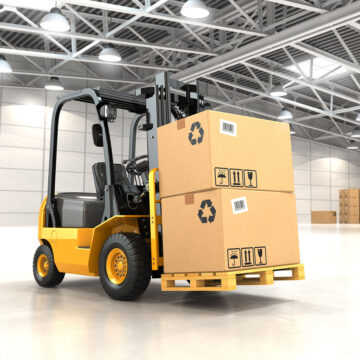Collisions between forklifts often occur in intersections, tight corners, narrow aisles and blind spots. Even during ordinary forklift operations, collisions and accidents still occur because of negligence and lack of safety tools in the workplace.
That’s why in this short article, we’ll discuss a few tips to minimise the number of forklift collisions. Let’s start.
1. Install alert systems to warn drivers when other forklifts or pedestrians are approaching
Lack of visibility and awareness often leads to forklift collisions and accidents. For instance, two forklifts might be approaching the same corner at the same time. If they’re meeting on a perpendicular position, it’s likely that the drivers won’t see each other.
It’s also the case when a pedestrian is nearby (e.g. people-dense and high-traffic environments). The pedestrian might be at the back and the driver is not yet aware. Any manoeuvre will put the pedestrian at risk.
Those scenarios will be prevented if there are alert systems in place. If the drivers were given proximity warning when another forklift or pedestrian is nearby (could be 1 to 6.5 metres away), they will have time to halt, manoeuvre or slow down.
2. Schedule forklift maintenance
Effective maneuvering is possible if the forklifts are in good condition. This means the brakes and engines should be working perfectly for the driver to effectively manoeuvre or slow down in time.
That’s why the forklifts should undergo regular maintenance. This way, forklift operators will have an easier time when driving material handling equipment. Whether it’s making a left turn or activating the brake on time, a forklift in good working condition is required to prevent collisions.
A maintenance alert system is valuable for these cases. There’s an improved assurance that the equipment will undergo maintenance procedures on time (before any part or component breaks down). Aside from preventing accidents, scheduled maintenance will also improve equipment performance and worker productivity.
3. All personnel should be trained on forklift safety (even workers who don’t operate forklifts)
Reliance on common sense (e.g. some pedestrians may assume that the driver can see them) could be dangerous and fatal. After all, many of the workplace accidents occur because of the failure of common sense to anticipate the risks.
That’s why there should be clear safety knowledge and procedures which can be gained through training of all personnel. This includes pedestrians or any work that might be assigned near the forklifts. This will bring everyone to the same page and prevent conflicts in case accidents do happen. Everyone will be aware of who is accountable. More importantly, accidents will be minimised in the first place.
Technologies for effective forklift collision avoidance
Modern logistical operations often demand modern solutions. It’s especially the case with workplace safety and preventing forklift collisions. Busy workplaces and complex operations may significantly increase the risks.
With reliable technologies in place, the workplace will experience minimal delays and accidents. That’s why many Fortune 100 corporations and small businesses get in touch with us for pedestrian alert and collision avoidance systems.


